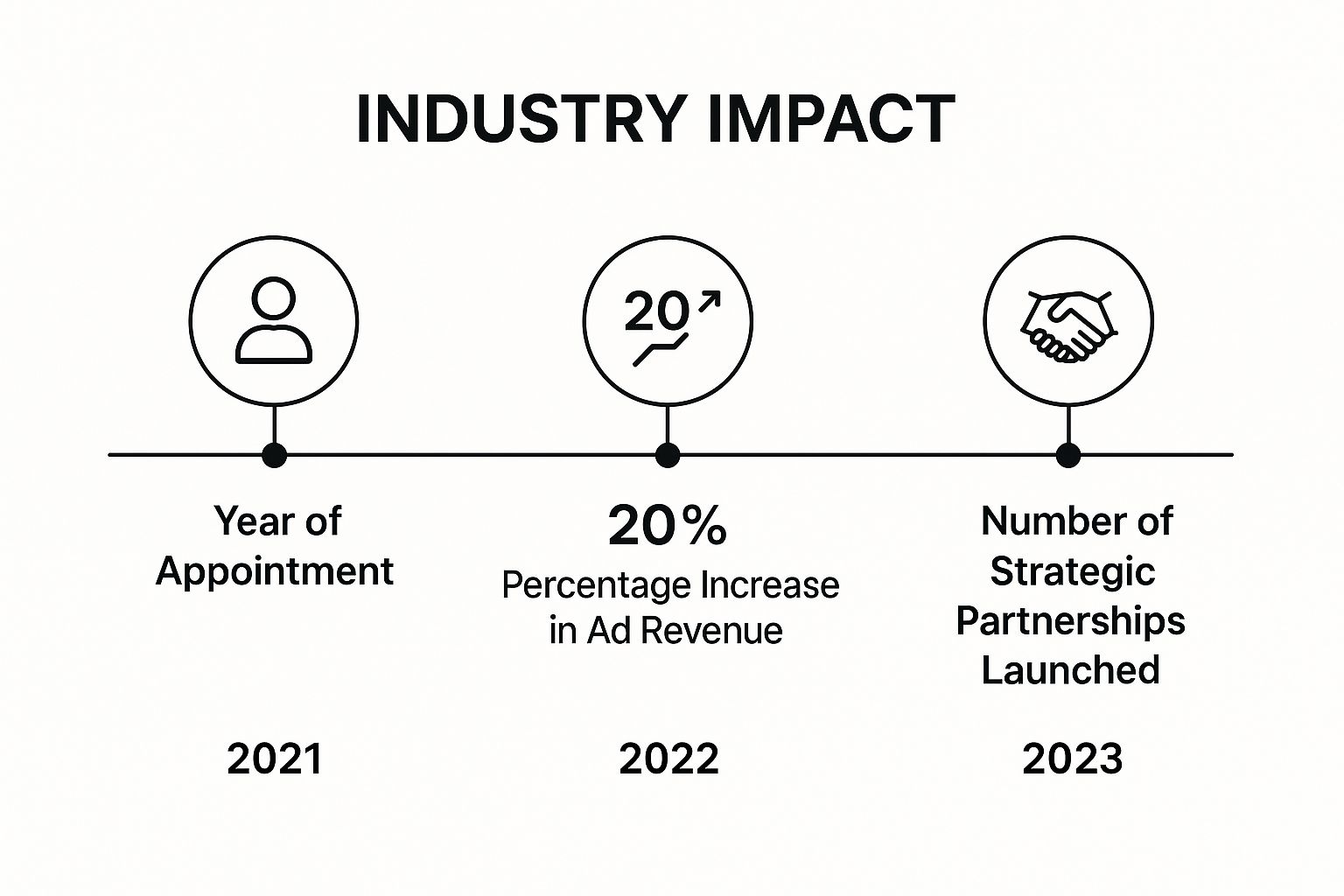Ever wondered who’s really pulling the strings behind YouTube’s biggest business moves? When a new monetization tool drops or a massive partnership gets announced, it’s not magic—it’s the YouTube Chief Business Officer (CBO). This isn't just another stuffy corporate title; it's the person steering the entire business side of the platform, from ad deals to the creator economy itself.
For creators, educators, and researchers, understanding this role is more than just trivia—it's a strategic advantage. Let's dive into what the CBO does, who holds the position, and most importantly, how their decisions directly impact your channel's growth and profitability.
What the YouTube CBO Role Means for You
Think of the YouTube Chief Business Officer as the master architect of the entire creator ecosystem. Their job is to build and strengthen the bridges that connect your channel, global advertisers, and all the ways you make money, like Memberships and Super Thanks. At its core, the CBO's mission is to grow YouTube's business, which means your success is their success.
The decisions coming from the CBO’s office aren't just high-level strategy; they directly shape the tools you use every day, the revenue you earn, and the very ground you build your channel on. So when YouTube rolls out a major policy update or a new feature, you can bet it started as a business goal at this executive level.
This role became absolutely essential after Google's landmark acquisition of YouTube back in October 2006 for a cool $1.65 billion. That single event put YouTube on a new trajectory, one that required a far more sophisticated business engine to handle complex partnerships and worldwide monetization. If you want to dive deeper into the acquisition and its ripple effects, you can find more insights on SurgeGraph.
The CBO's strategy isn't just an abstract plan—it's a roadmap for the entire platform. Understanding their priorities gives you a serious head start, letting you align your channel’s growth with where YouTube is headed next.
For creators, this means paying close attention. The CBO’s public announcements and initiatives are breadcrumbs leading to the future. They tell you which types of content and features are about to get a major investment and a promotional push.
Before we dive deeper, let's break down exactly what the YouTube CBO is responsible for. This table gives you a quick snapshot of their key duties and, more importantly, what each one means for you as a creator.
Core Responsibilities of the YouTube CBO
| Responsibility Area | What It Means for Creators |
|---|---|
| Content & Distribution Partnerships | Forging deals with major media companies and music labels. This directly impacts things like Content ID and the music available in the Audio Library. |
| Monetization Ecosystems | Developing and managing every revenue stream—from AdSense to YouTube Premium and creator-funding tools. This determines how you earn money. |
| New Product & Market Expansion | Overseeing the rollout of new features (like Shorts) and pushing YouTube's growth into new global markets, opening up potential new audiences for you. |
As you can see, their influence is everywhere. From the ads that run on your videos to the new features that pop up in your Studio dashboard, it all ties back to the business strategy helmed by the CBO.
Ultimately, getting a handle on the YouTube Chief Business Officer's role helps you shift from just being a passenger on the platform to being a co-pilot. You'll start making smarter, more informed decisions that can put your channel on the fast track to success.
Meet Mary Ellen Coe, YouTube's Current CBO

The person currently at the helm of YouTube’s massive business engine is Mary Ellen Coe. For creators, her background is particularly telling. Before taking the CBO role at YouTube, she led Google's Customer Solutions, where her entire mission was helping millions of small and mid-sized businesses find their footing online.
That experience is a huge deal, as it mirrors the journey of most creators. She now oversees the entire global business strategy for YouTube, which includes the monetization ecosystem that fuels your channel. We're talking ad revenue, creator funding tools, and even the big subscription services like YouTube TV, Music, and Premium.
Her appointment really signals YouTube's ongoing commitment to building a more durable and diverse creator economy.
A Focus on Sustainable Creator Careers
Under Mary Ellen Coe’s watch, the focus isn't just on viral moments; it's about building sustainable, long-term careers on the platform. As the YouTube Chief Business Officer, she is directly responsible for the strategic calls that roll out new income streams and content formats. This is exactly why understanding her role—and the wider leadership team—is so important for any serious creator, educator, or researcher.
Her leadership philosophy connects the dots between large-scale business operations and the individual creator's bottom line. The goal is to create a platform where more creators can build a viable living.
This approach fits perfectly with YouTube’s position as a subsidiary of Google, where scalable, data-driven growth is baked into the company's DNA. Every new feature or partnership is a piece of a much larger puzzle, designed to keep the platform competitive and profitable for everyone involved. For a deeper dive into this corporate family tree, you can check out our guide on who owns YouTube and how that ownership shapes its direction.
Ultimately, her leadership gives creators a clearer roadmap of where the platform is headed. By paying attention to the initiatives she champions, you can better position your channel for what comes next.
How the CBO Directly Impacts Your Monetization

It’s easy to think of a YouTube Chief Business Officer as some distant corporate figure, completely disconnected from your day-to-day grind. But the truth is, their decisions have a direct line to your bank account.
Every single monetization feature you use—from AdSense revenue splits and Channel Memberships to Super Chat tips—started as an idea within the CBO's strategic vision.
When a new way for you to earn money pops up, it’s because the CBO’s teams have painstakingly built the business case for it. They're the ones in the background, striking the deals and designing the entire ecosystem to make sure it works for creators, advertisers, and YouTube itself.
This is especially true for creators in specialized niches. If you're an educator, the CBO’s strategy could lead to dedicated funding like YouTube Learning or new educational grants. These programs don't just materialize out of thin air; they are the result of top-level business moves becoming real opportunities for you.
From the C-Suite to Your Creator Studio
Those monetization tools in your dashboard? They are the final stop on a long business development journey. Let's break down the features that have come to define a modern creator’s income:
- YouTube Shopping: This powerful feature exists because the CBO’s office hammered out partnerships with e-commerce platforms like Shopify. The result is a smooth, integrated way for you to sell merch directly under your videos.
- Ad Revenue: That percentage you get from ads isn't just a random number. It's a critical part of the business model the CBO oversees to keep creators motivated and advertisers spending. While many viewers search for ways on how to block YouTube ads, a balanced ad ecosystem is what pays the bills for most channels.
- Alternative Monetization: Features like Super Thanks and Memberships were deliberately developed to help you diversify your income beyond ads, making a creator career far more stable. This was a strategic push to build a more resilient creator economy.
Every time a new button appears in your "Earn" tab, you're witnessing the CBO's strategy come to life. Their entire job is to create more of those buttons, giving you more ways to build a sustainable business.
At the end of the day, the CBO is playing the long game. If you pay attention to their focus, you can start to anticipate which tools will become central to YouTube's future. That lets you adapt your own strategy and turn their high-level business plans into your own financial success.
How the CBO Shapes YouTube’s Content and Partnership Strategy

The YouTube Chief Business Officer does a lot more than just count the money. Their strategic decisions directly influence what kinds of content blow up on the platform. By striking high-level deals with huge media companies, music labels, and global brands, the CBO’s office essentially builds the playground where every creator operates.
These partnerships aren't just abstract corporate handshakes; they have real, tangible effects on your channel. The music you find in Creator Music, the brands lining up for sponsorships, and even the nitty-gritty rules around copyrighted material—all of these are direct results of deals cut at the executive level.
Think of the CBO as a city planner. Their choices determine where the major highways get built and which neighborhoods become the hottest spots in town. When YouTube suddenly pushes a new format like Shorts or starts pouring money into podcasts, that’s no accident. It’s a calculated business move, straight from the CBO's playbook. For smart creators, these big moves are flashing green lights.
Reading the Tea Leaves of Content Strategy
Paying attention to these signals is like getting a sneak peek at the platform's game plan. When top leaders like CBO Mary Ellen Coe start talking up a specific area, it’s a pretty clear sign of where money, resources, and even algorithmic love are about to flow. Aligning your channel with this bigger vision can give your content a serious tailwind.
Here’s what to watch for:
- Big Investments in Formats: If YouTube is dropping a ton of cash on new live streaming tools and promotions, it’s a massive hint that producing quality live content could get you more visibility and better monetization.
- New Partnership Announcements: Did YouTube just announce a major partnership with a big gaming company or an educational platform? That’s a signal of a growing market on the platform that you can tap into.
- Where the Monetization Goes: When new ad formats or revenue streams pop up for a specific type of content (like Shorts ads), it shows YouTube is committed for the long haul. That makes it a much safer bet for your own time and investment.
By watching these top-down business moves, you can start anticipating platform shifts instead of just reacting to them. It’s a proactive approach that helps you ride YouTube’s waves for more sustainable growth.
Ultimately, the CBO’s strategy gives you a blueprint for what success looks like on YouTube right now. If you learn to decode these signals, you can position your channel to catch the next big opportunity before everyone else does.
How to Research CBO Strategy for Your Channel
So, how do you get inside the minds of YouTube's top brass without an all-access pass? It's easier than you think. As a creator, you can get a sneak peek into the platform's future by paying close attention to what its leaders, like the YouTube Chief Business Officer, say in public.
These executives are constantly dropping clues about YouTube’s priorities at industry conferences, in earnings calls, and on the company’s official blog. The challenge? No one has time to sit through hours of dry corporate presentations. You need a smarter, more direct way to get to the good stuff.
Turn Speeches into Searchable Strategy
The real trick is to "read the tea leaves" by analyzing the exact language these leaders use. By converting their spoken words into searchable data, you can spot emerging trends and strategic shifts long before they hit the mainstream.
Here’s a simple, step-by-step way to do it:
- Find a Key Video: Grab a link to a recent keynote, interview, or presentation featuring a high-level YouTube executive.
- Get the Transcript: Use a tool like the YouTube Transcript Extractor to pull a full, time-stamped text version of everything said in the video. This is ideal for researchers needing to cite specific moments or creators looking for soundbites.
- Analyze the Text: Now you have a searchable document. Use Ctrl+F to hunt for keywords relevant to your niche, like “creator economy,” “AI tools,” “podcasting,” or “new monetization.”
This screenshot shows just how simple it is. You paste a video URL into the YouTube Navigator tool, and it instantly spits out a clean transcript. A long, unsearchable video becomes a goldmine of strategic intel in seconds.
By tracking how often certain topics pop up, you can start aligning your own content strategy with where YouTube is investing its time and money. Think of it like market research, but for your channel. While a CBO is busy managing massive operations, like the entire ecosystem of YouTube TV channels, their public statements provide direct, actionable clues for creators of every size.
The Evolution of YouTube's Business Leadership
To really get why the YouTube Chief Business Officer role is so crucial today, you have to look back at how the platform got here. YouTube’s journey from a quirky video-sharing site to a global media giant wasn't an accident—it was shaped by sharp business leadership at just the right moments.
Early leaders like Susan Wojcicki were at the helm during YouTube's explosive growth. They were the ones who pushed for foundational ideas like the YouTube Partner Program, which was the first real move toward creating a professional class of creators. As the platform ballooned, so did its problems—copyright battles, global expansion, and the tricky task of building an ad model that actually worked.
This growing complexity created a vacuum for a more specialized, powerful business leader. By 2010, YouTube was already a giant, capturing 43% of the online video market with over 14 billion views a month. After the founders stepped away, leaders like Salar Kamangar and later Wojcicki guided YouTube through massive global expansions and monetization strategies. You can get a deeper look into this critical time on YouTube's history on Wikipedia. This period cemented the need for a CBO to steer the increasingly complex business ship.
The infographic below shows just how much business leadership mattered, connecting executive appointments to revenue growth and strategic partnerships.

As you can see, every new phase of leadership kicked off a major jump in both revenue and platform-defining deals. History shows a clear pattern here: as YouTube’s scale and ambitions grew, so did the need for a dedicated executive to run the business side. This set the stage for the modern CBO, whose decisions now shape everything from content trends to creator careers. To learn more about keeping up with these shifts, check out our guide on generating fresh video ideas for your YouTube channel.
Still Have Questions? Let's Clear Things Up
Got a few more questions floating around about the YouTube Chief Business Officer and what the role actually means for your channel? You're not alone. Let's tackle some of the most common ones we hear from creators, educators, and researchers.
How Can I Follow The CBO's Latest Strategies?
The best way is to keep a close eye on the official YouTube Creator Blog and tune into key industry events like VidCon or Google I/O, where executives often share high-level plans.
But if you want a smarter, faster approach, try using the YouTube Transcript Extractor. This practical tool turns a long video into a searchable document. Instead of sitting through an hour-long keynote, you can instantly find every mention of strategic phrases like "creator tools" or "monetization updates." It’s an invaluable research aid.
Does The CBO Interact Directly With Creators?
Not usually, at least not in a one-on-one capacity. Think of the CBO as the architect designing the entire game board. They don't move the individual pieces, but their strategy sets the "rules of the game" for the whole YouTube community.
The people who do carry out that strategy are the teams you might interact with, like YouTube Partner Managers and the creator liaisons you see online. The CBO’s vision trickles down through them to you.
Why Does The CBO Matter For A Small Channel?
This is a big one. The CBO's strategy defines the path to success for every channel, no matter the size. Their decisions directly shape things like:
- Monetization eligibility requirements
- Which content formats get an algorithmic boost (like Shorts)
- What new tools are built for creators
Paying attention to their focus helps you make smarter decisions right from day one, aligning your channel's growth with where the platform is headed.
Ready to turn high-level strategy into your own competitive advantage? Start with the powerful, free tools from YouTube Navigator. Analyze executive interviews with the YouTube Transcript Extractor or perfect your channel's branding with our YouTube Thumbnail Maker to stay ahead of the curve.

Leave a Reply